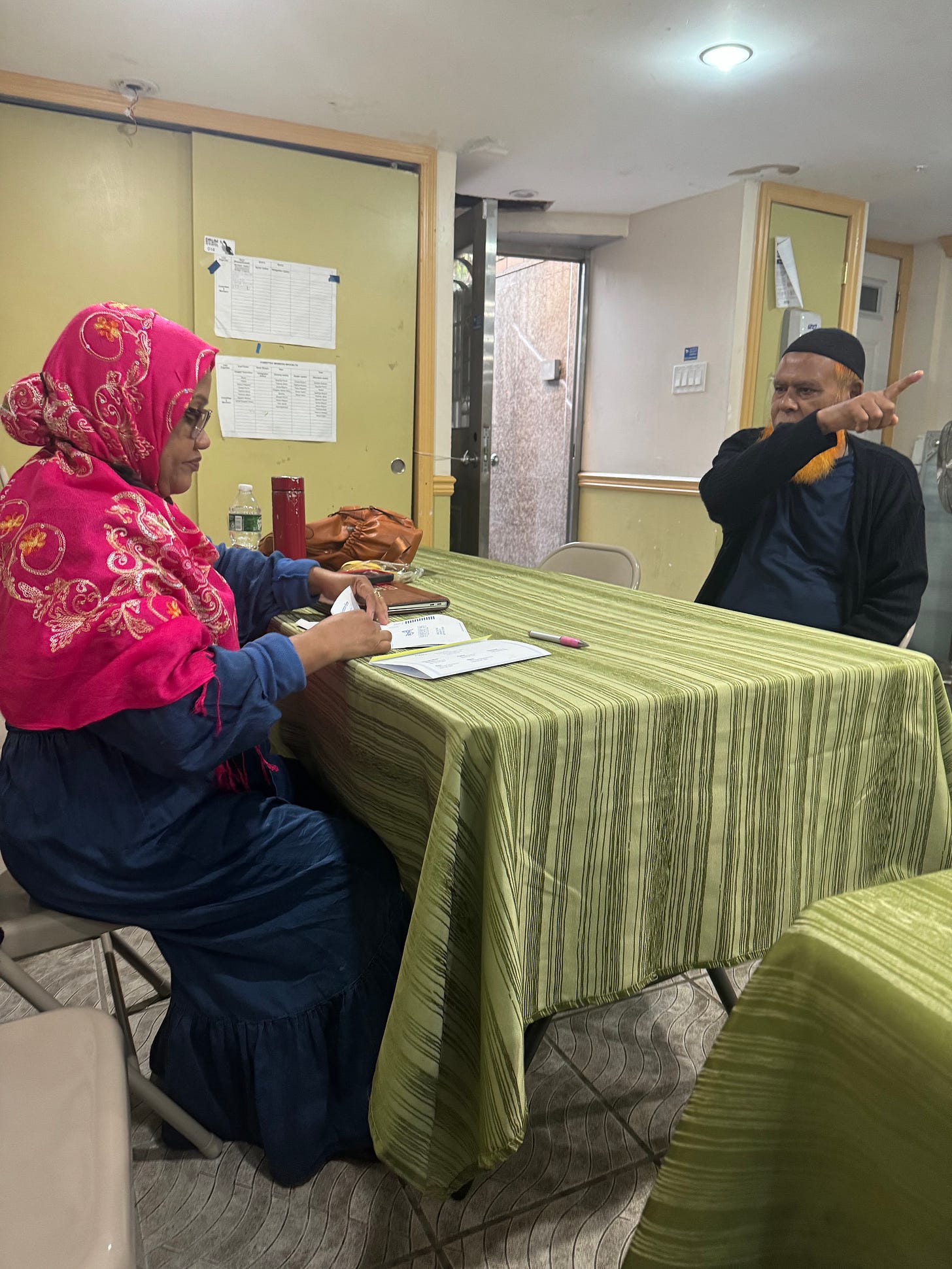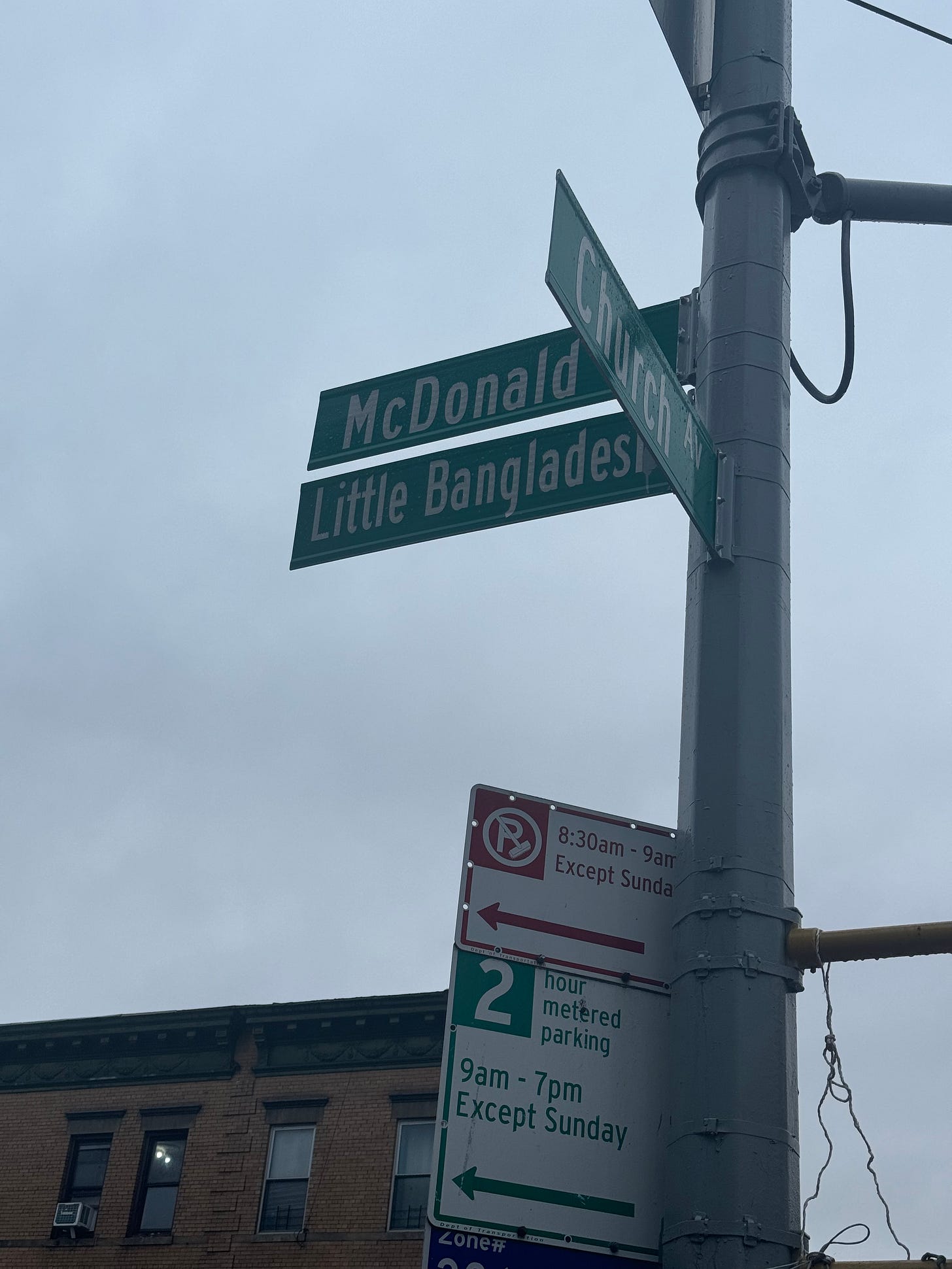Dispatches from the NYC Mayoral Trail: Kensington Brooklyn and DRUM Beats
Third part of the series on reports from New York's South Asian neighborhoods
As the race for the NYC Mayoral Primary heats up (we are officially less than five days until Election Day at the time of writing this piece), calculations of all sorts are being drummed up to decipher whether Zohran Mamdani, the close second Mayoral candidate can beat the former New York Governor and current front runner Andrew Cuomo to become the first South Asian Mayor of New York City. Social media, particularly Twitter and Instagram, have not been as relevant for the liberal/left leaning sections of New York as over the last few weeks, where almost every liberal leaning influencer and lay poster are uploading selfies with Mamdani or posters of his campaign, and making videos urging New Yorkers to vote for him.
Voters between the ages of 25-44 are leading in early voter turnout and this election has already (and accurately) been called as ‘among the most historic NYC Mayoral Elections in recent memory’ — after all Zohran Mamdani’s campaign has knocked over a million doors in the city and over 3,000 volunteers packed a pre-election rally with Zohran Mamdani and arguably the most recognized progressive politician in America, Alexandria Ocasio Cortez (AOC), just last weekend on June 14. The city feels as electric as it has been, even if you are not hawkishly following election coverage, as some of us.

But in this corner of the Internet, we remain laser focused on all things South Asian, especially when it comes to the NYC politics and the Mayoral election. On June 16, I published my long anticipated story on the South Asian voters and their response to Zohran Mamdani’s campaign in New Lines Magazine (which you can read here). After reporting on this story for weeks, if not months, traveling to at least a dozen desi neighborhoods (and Staten Island), and interviewing over 70 people for the piece, I finally sat down to coalesce everything I had gathered into a few thousand words — a monumental if not entirely impossible task — and had to leave a lot of crucial voices and reporting on the table that could not make it into the final edit.
But I have been reporting on my dispatches from the Mayoral election trail for some time now (you can read the first two installments here and here) and this post is another run up in the same series, where I share the behind the scenes reporting from looking into the South Asian political engagement in NYC. It is by far among the most rewarding journalism I have done since moving to New York, and I hope you read along and get an insider’s view into some of the most underreported communities of this city.
Kensington, Brooklyn
South Asian communities, particularly those that have recently immigrated are often perceived as politically disengaged and uninvolved in the voting process. Many individuals I interviewed openly said they neither had the time to discuss politics, nor the interest in doing so. Experts and movement leaders pointed out to the existing voting behaviors in their origin countries of India, Pakistan, Bangladesh, Nepal and Sri Lanka, where many feel disenfranchised from their right to vote and disillusioned with the promise of its outcomes, with election malpractices like booth capturing, tampering of electoral rolls and votes for pay becoming increasingly common during each cycle. Grassroots organizations like DRUM Beats and CAAAV Voice, that are focused on working class immigrant Asian and South Asian communities recognize this gap, and have been the backbone of the Zohran Mamdani campaign in reaching out to South Asian voters, particularly from working class backgrounds in NYC.
During my visit to Kensington in Brooklyn, where almost 62% of the total Asian population is South Asian, split almost down the middle between Indian and Bangladeshi New Yorkers, I had the chance to see a phone banking operation in action at the local DRUM Beats office in the area. Drum BEATS, an affiliate of DRUM (Desis Rising Up and Moving) — which is one of the oldest (and perhaps among the most significant) South Asian focused focused orgs in New York — endorsed Mamdani’s campaign in October, soon after he announced his run for Mayor. With locations and affiliates in almost all South Asian majority neighborhoods in the city, DRUM Beats has been instrumental in mobilizing South Asian New Yorkers to canvass and vote for Mamdani’s campaign. In Kensington, the Drum BEATS phone bank for Mamdani was helmed by Bangladeshi New Yorker Kazi Fouzia, who is the Director of Organizing at DRUM.
Despite the heavy rains outside on a mid-May afternoon, the basement office was buzzing with folks having phone conversations with voters in Bengali, while Fouzia was speaking to someone who seemed like an unregistered voter, explaining to him the significance of registering to vote before the elections. In our conversation, Fouzia, who was plugged into minute-by-minute updates around the evolving campaign, talked about Mamdani’s advocacy with the community, both in Albany and outside. When I brought up what at the time was a freshly released poll, in which Cuomo was polling around 46% and Mamdani at 23%, Fouzia defiantly said that the pollsters have never included South Asians in their tallies. “Since 2019 I never [got] any poll request. So the Muslim community, South Asian community, working class community did not get [any] poll request. I [don’t] believe this poll 100%, we believe Zohran will be win because we are not counted in the poll”, she said.
Canvassing in a neighborhood that also included Latin American, Black and Jewish New Yorkers was not always easy for Fouzia and her team, where almost all women and men (with a few exceptions) were visibly identifiable as Muslim. “Lot of these people are very, very hostile and angry with Zohran. Maybe we are in a district where probably lot of people don’t like Filistine (Palestine) and support Filistine. So that’s why their anger is [which] I understand. But we are getting lot of support,” she said. As the rains let up for a few hours and the day slipped into evening, the group brought out their food stash of home cooked pakoras and chai— a typical rainy day snack in most South Asian countries, and Fouzia mentioned how homemade South Asian snacks (cooked by the DRUM Beats canvassers) have been a hit at canvassing operations, where many of their neighbors come for the chai and stay for the chat.
We don’t support Zohran because when he smiles, he has a dimple. We don't support Zohran because he’s a very nice looking guy. We love Zohran and support Zohran because of all campaign promises related to us, about us — Kazi Fouzia, Director of Organizing, DRUM.
During that short break from nonstop phone banking, the conversation veered into Islamophobia in the wake of the September 11, 2001 attacks, and how many of the women had urged each other to stop wearing any items of clothing that could be identified as markers of Muslim identity. Some added that they continued to face harassment in the neighborhood, despite the office’s location on a street that had been recently named ‘Little Bangladesh’. The name changed which happened in October 2022, came soon after the neighborhood became among the handful of Brooklyn areas that voted to elect Shahana Hanif to city council, making her the first Muslim woman and Bangladeshi American Council Member in New York. Hanif, who is also facing a re-election on June 24 in the Democratic Primary endorsed Mamdani and like him is a Democratic Socialist who went on a hunger strike to advocate for taxi drivers in 2021. Fouzia mentioned that they were canvassing both for Mamdani and Hanif during their phone banking and urged people to vote for them because of their policies. “Identity politics is dangerous,” she said, “Bangladeshi City Council Members are very tokenized and very identity related. We are not voting for Shahana because she is Bangladeshi but because of her organizing and commitment and solidarity [towards] continuously fighting for us,” Fouzia told me.
Fouzia, like other community members from DRUM and beyond that I interviewed, maintained that while Mamdani and Hanif’s shared background could be a gateway for the organizations to reach out to South Asian New Yorkers, it was their policies that mattered most to them and their communities, who have often been sidelined by most NYC politicians. She also mentioned that among the several reasons political engagement among the Bangladeshi community in Kensington was low was because not many politicians in the past had made an effort to reach out to the community or invest in voter education. Lack of awareness around the American political machinery, and various political candidates and their policies have made South Asian New Yorkers somewhat vulnerable to be influenced by tokenistic gestures made by politicians around election season. “They take a picture with us, say a few nice words in Punjabi, say Dhanobaad (thank you in Bangla) or As-salamu Alaikum (Urdu greeting) and that impresses our people. It’s more than enough [for us], whatever their politics,” Fouzia told me.
While their votes have always mattered to those who were seeking them, the people doing the voting seemed to have figured less in those calculations. Based on what I heard from several community members, NYC politicians have in the past chosen to reach out to the South Asian communities through what Fouzia described as ‘ethnic leader gatekeepers’ — certain community leaders who have historically paved the way New York City politicians to make inroads in South Asian spaces, allowing the politicians to avail their support without holding them accountable for their policies that actively harm desi New Yorkers (I have also covered this extensively in my New Lines Magazine piece). Like in the case of Andrew Cuomo, who accepted a $1M donation from DoorDash, which could make him beholden to potentially overturning the minimal wage policies and worker protection laws that were passed in 2021, and directly impact Bangladeshi New Yorkers, many of whom work as delivery workers (often for DoorDash) and live in Kensington. Although Cuomo has been criticized in the past (and most recently by Mamdani at the last NYC Mayoral Debate on June 12) for not visiting a mosque in over a decade, particularly during his time as the New York governor, he has been to a few Gurudwaras (Sikh temples) to garner support from Sikh and Punjabi New Yorkers for his candidacy as Mayor.
Regardless of the outcome of this election, it is evident that through one of the largest volunteer operations the city has witnessed so far, Mamdani and the organizations that support him have managed to engage (and mobilize) a vast section of South Asian New Yorkers who otherwise would not consider staking a claim to city politics and their role in shaping it. Even though Zohran Mamdani’s campaign has vehemently refused their intention to claim any pyrrhic or moral victories, remaining laser focused on getting the real election win instead, it is abundantly clear that the impact of his campaign has already changed New York and its desi communities as we know it.
More
Related reading on the NYC Mayoral Election:







Thank you for covering the South Asian population in this mayoral election; they are a vital voting block and there is seldom much coverage of their views, politics and so on.